
Pepsis is a genus of spider wasps belonging to the family Pompilidae.

Episyron is a genus of wasps in the family Pompilidae which prey on spiders. Nine species are found in Europe.

The Pompilinae are a subfamily of the spider wasp family, Pompilidae, the species of which lay their eggs on the paralysed bodies of their prey.

Anoplius is a genus of spider wasps in the family Pompilidae, called the blue-black spider wasps.

The Pepsinae are a subfamily of the spider wasp family, Pompilidae, including the tarantula hawks, as well as smaller species.
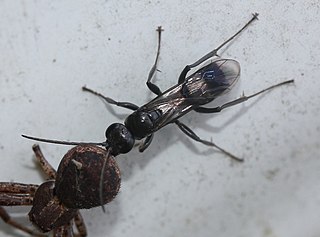
Dipogon is a genus of spider wasps of the family Pompilidae in the subfamily Pepsinae. They are found in Europe, Asia, and North America. Their generic name comes from the characteristic long bristle tufts just below the mandibles, which are used to carry material to construct the cells in the nest, and for constructing the nest.
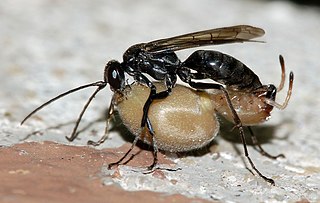
Auplopus is a large genus of spider wasps belonging to the subfamily Pepsinae of the spider wasp family Pompilidae, distributed throughout the world except for Antarctica. Auplopus wasps have the gruesome habit of amputating the legs of their spider prey before transporting it to the nest.
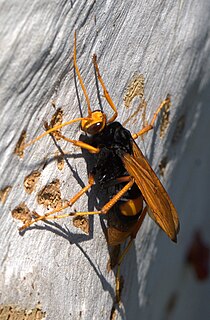
Cryptocheilus is a genus of spider wasps of the subfamily Pepsinae, they are found in the world's warmer regions. They vary in size from medium to large and are often strikingly coloured. The females construct multicellular nests in cavities, once built each cell is stocked with a spider, captured by the female. They are found in open habitats such as heaths, meadows and forest edges.
Epipompilus is a genus of spider wasps in the subfamily Ctenocerinae, part of the widespread family Pompilidae. Representatives of Epipompilus can be found in Australasia and North and South America. This distribution may indicate that Epipompilus evolved in Gondwana and is similar to other Gondwanan taxa such as the southern beech Nothofagus and Auracaria.

Aporus is a genus of spider wasps from the family Pompilidae, they specialise in hunting ground dwelling spiders in their burrows for laying eggs on.
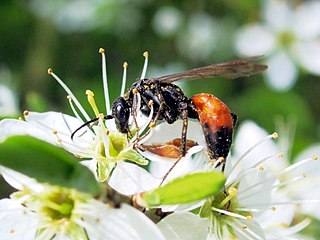
Priocnemis is a genus of pepsine spider wasp containing around 30 species.
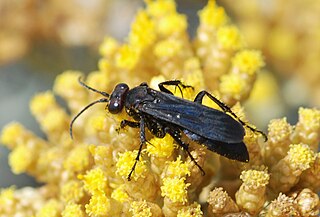
Agenioideus is a genus of spider wasps from the subfamily Pompilinae; the genus occurs in Europe, where 21 species are recorded, eastwards to Japan, in North America, South America, and Australia.

Caliadurgus is a genus of spider wasps of the subfamily Pepsinae. These are medium-sized black spider wasps with some red. They have a catholic habitat choice and their preferred prey are spiders of the families Araneidae and Tetragnathidae. They have a Holarctic and Neotropical distribution.
Priochilus captivum is a species of neotropical spider wasp in the family Pompilidae. It is native to Central and South America. It was first described by the Danish zoologist Johan Christian Fabricius in 1804.

Batozonellus a genus of the spider hunting wasps.
Ireangelus is a genus of kleptoparasitic spider wasps from the sub-family Ceropalinae of the family Pompilidae. The genus has a pan tropical distribution,being known from Oriental, Neotropical, Australian, eastern Palearctic, and Madagascan Zoogeographic regions being best represented in the Neotropics. Irenangelus is closely related to the more widespread genus Ceropales, the two genera forming a monophyletic subfamily, Ceropalinae within the Pompilidae. This is regarded as the most basal grouping of the Pompilidae but this view is problematic because of the kleptoparasitic life history of the Ceropalines, it is now considered that they Ceropalines and other pompilids evolved from a common ectoparasitoid ancestor.

Tachypompilus is a genus of spider wasps, found in the Neotropics Nearctic, eastern Palearctic, Indomalayan and Afrotropics.

Poecilopompilus is a fossorial genus of the family Pomplidae found in the New World. The main prey of these wasps are spiders of the family Araneidae.
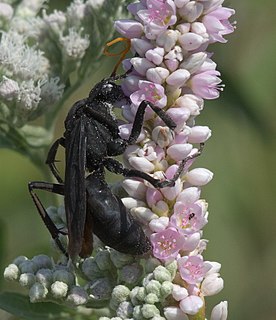
Entypus is a genus of spider wasps in the family Pompilidae. There are at least 40 described species in Entypus.

Psorthaspis is a genus of spider wasps in the family Pompilidae. There are more than 30 described species in Psorthaspis.
















